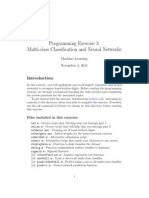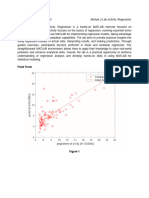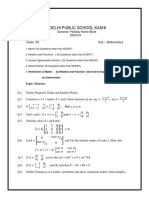Tutorial Ex3
Uploaded by
Kartik ChouhanTutorial Ex3
Uploaded by
Kartik ChouhanTutorial: ex3 oneVsAll()
Tom Mosher
MentorAssignment: Multi-class Classification and Neural Networks · 4 years ago · Edited
all_theta is a matrix, where there is a row for each of the trained thetas. In the exercise example,
there are 10 rows, of 401 elements each. You know this because that's how all_theta was
initialized in line 15 of the script template.
(note that the submit grader's test case doesn't have 401 elements or 10 rows - your function
must work for any size data set - so use the "num_labels" variable).
Each call to fmincg() returns a theta vector. Be sure you use the lambda value provided in the
function header.
You then need to copy that vector into a row of all_theta.
The oneVsAll.m script template contains several Hints and a code example to guide your work.
The "y == c" statement creates a vector of 0's and 1's for each value of 'c' as you iterate from 1 to
num_labels. Those are the effective 'y' values that are used for training to detect each label.
Type these commands in your workspace to see how to copy a vector into a matrix:
Q = zeros(5,3) % create a test matrix of all-zeros
v = [1 2 3]' % create a column vector
Q(2,:) = v % copy v into the 2nd row of Q
The syntax "(2,:)" means "use all columns of the 2nd row".
ex3: tutorial for predictOneVsAll()
Tom Mosher
MentorWeek 4 · 4 years ago · Edited
The code you add to predictOneVsAll.m can be as little as two lines:
1. one line to calculate the sigmoid() of the product of X and all_theta. X is (m x n), and all_theta is
(num_labels x n), so you'll need a transposition to get a result of (m x num_labels)
2. one line to return the classifier which has the max value. The size will be (m x 1). Use the "help
max" command in your workspace to learn how the max() function returns two values.
Note that your function must return the predictions as a column vector - size (m x 1). If you return
a row vector, the script will not compute the accuracy correctly.
ex3 tutorial for predict()
Tom Mosher
MentorWeek 4 · 4 years ago · Edited
Here is an outline for forward propagation using the vectorized method. This is an
implementation of the formula in Figure 2 on Page 11 of ex3.pdf.
1. Add a column of 1's to X (the first column), and it becomes 'a1'.
2. Multiply by Theta1 and you have 'z2'.
3. Compute the sigmoid() of 'z2', then add a column of 1's, and it becomes 'a2'
4. Multiply by Theta2, compute the sigmoid() and it becomes 'a3'.
5. Now use the max(a3, [], 2) function to return two vectors - one of the highest value for each
row, and one with its index. Ignore the highest values. Keep the vector of the indexes where the
highest values were found. These are your predictions.
Note: When you multiply by the Theta matrices, you'll have to use transposition to get a result
that is the correct size.
Note: The predictions must be returned as a column vector - size (m x 1). If you return a row
vector, the script will not compute the accuracy correctly.
Note: Not getting the correct results? In the hidden layer, be sure you use sigmoid() first, then
add the bias unit.
------ dimensions of the variables ---------
a1 is (m x n), where 'n' is the number of features including the bias unit
Theta1 is (h x n) where 'h' is the number of hidden units
a2 is (m x (h + 1))
Theta2 is (c x (h + 1)), where 'c' is the number of labels.
a3 is (m x c)
p is a vector of size (m x 1)
You might also like
- Graphs with MATLAB (Taken from "MATLAB for Beginners: A Gentle Approach")From EverandGraphs with MATLAB (Taken from "MATLAB for Beginners: A Gentle Approach")4/5 (2)
- Aula 4 (L) - Oggi La Tua Lezione È in PresenzaNo ratings yetAula 4 (L) - Oggi La Tua Lezione È in Presenza11 pages
- A Journey From Linear Algebra To Machine LearningNo ratings yetA Journey From Linear Algebra To Machine Learning50 pages
- Machine Learning - Home - Week 2 - Notes - CourseraNo ratings yetMachine Learning - Home - Week 2 - Notes - Coursera10 pages
- IN5400 - Machine Learning For Image AnalysisNo ratings yetIN5400 - Machine Learning For Image Analysis6 pages
- CS 229, Public Course Problem Set #1 Solutions: Supervised LearningNo ratings yetCS 229, Public Course Problem Set #1 Solutions: Supervised Learning10 pages
- A Brief Introduction to MATLAB: Taken From the Book "MATLAB for Beginners: A Gentle Approach"From EverandA Brief Introduction to MATLAB: Taken From the Book "MATLAB for Beginners: A Gentle Approach"2.5/5 (2)
- Lec4 Oct12 2022 PracticalNotes LinearRegressionNo ratings yetLec4 Oct12 2022 PracticalNotes LinearRegression34 pages
- Vertopal.com C1 W2 Lab02 Multiple Variable SolnNo ratings yetVertopal.com C1 W2 Lab02 Multiple Variable Soln11 pages
- 17 Ensemble Techniques Problem StatementNo ratings yet17 Ensemble Techniques Problem Statement28 pages
- Ex4 Tutorial - Forward and Back-PropagationNo ratings yetEx4 Tutorial - Forward and Back-Propagation20 pages
- 1.1 ID5059 1.2 Tom Kelsey - Jan 2021: February 15, 2021No ratings yet1.1 ID5059 1.2 Tom Kelsey - Jan 2021: February 15, 202143 pages
- Matrices with MATLAB (Taken from "MATLAB for Beginners: A Gentle Approach")From EverandMatrices with MATLAB (Taken from "MATLAB for Beginners: A Gentle Approach")3/5 (4)
- Neural Network Package For Octave Developers GuideNo ratings yetNeural Network Package For Octave Developers Guide31 pages
- Ai Ml Exam_1march 16 2022-Michael MagreolaNo ratings yetAi Ml Exam_1march 16 2022-Michael Magreola8 pages
- RS Aggarwal Class 12 Solutions Chapter-7No ratings yetRS Aggarwal Class 12 Solutions Chapter-760 pages
- Introduction To Tensors: Contravariant and Covariant VectorsNo ratings yetIntroduction To Tensors: Contravariant and Covariant Vectors18 pages
- IIT JAM 2025 Mathematics Syllabus: Topic Wise Syllabus, Exam Pattern & Important BooksNo ratings yetIIT JAM 2025 Mathematics Syllabus: Topic Wise Syllabus, Exam Pattern & Important Books11 pages
- 11th Maths EM 2nd Revision Exam 2024 Question Paper Pudhukottai District English Medium PDF DownloadNo ratings yet11th Maths EM 2nd Revision Exam 2024 Question Paper Pudhukottai District English Medium PDF Download4 pages
- Numerical Linear Algebra With Applications SyllabusNo ratings yetNumerical Linear Algebra With Applications Syllabus2 pages
- Grade 10 Mathematics Common Schemes Term 1 To 30% (1)Grade 10 Mathematics Common Schemes Term 1 To 34 pages
- Functional Analysis: With Applications in Numerical AnalysisNo ratings yetFunctional Analysis: With Applications in Numerical Analysis7 pages
- Mathematical Tools of Quantum Mechanics by AdityaNo ratings yetMathematical Tools of Quantum Mechanics by Aditya3 pages
- Tips - The Ocean Circulation Inverse Problem PDF100% (1)Tips - The Ocean Circulation Inverse Problem PDF464 pages

























































































